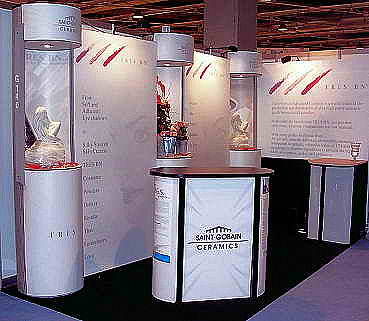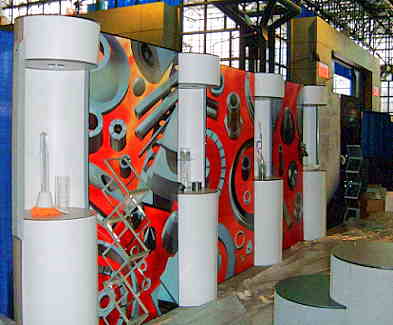Trade Show Display Co.
1.808.888.9988
Trade Show News
12/20/07
Trade shows can be hostile.
Daryl-Lynn Carlson
Financial Post
Planning for a trade show is a science, says advisor Barry Siskind. Trade and consumer shows offer tremendous opportunity to make sales, network and scope out competition, although most entrepreneurs don't know how to achieve these objectives, says a leading expert.
Many exhibitors can't articulate precisely why they are there, says Barry Siskind, a trade show and exhibiting specialist and president of International Training and Management Company in Toronto.
To illustrate this point, Mr. Siskind kicks off his book, Powerful Exhibit Marketing, with the old song lyrics, "We're here because we're here because we're here because we're here" suggesting this can serve as a theme song for 80% of trade show exhibitors. "Planning and organizing for a show is so much more than logistics,"
Mr. Siskind says. "It's a science." Mr. Siskind helps companies develop strategies and train booth staff to ensure a return on investment at shows. He says shows are ideal for entrepreneurs just starting out. "For a brand-new company just getting into a business, this is an opportunity to do face-to-face marketing, get out there, talk to people, build relationships and create the experience." "There's a growing need for returns on investments so it's important to carefully choose which shows to attend," he says, noting there are 13,120 registered trade shows across North American each year, along with smaller regional events.
He suggests exhibitors define their target audience. Booth staff often have only 30 seconds or less to make an impression, prompting Mr. Siskind to declare a trade show "a harsh, hostile, unfriendly environment to work in." Data gathered from formal audits of trade shows offer potential participants detailed information about the type of people who typically patronize the event. "Exhibitors are not impressed with just the quantity of people, what they need to know is the quality of people," he says. "So, more shows are being audited to provide exhibitors with that information. Then you can see if the people you're looking for is going to that show in sufficient numbers."
Many exhibitors hold a draw for a prize and ask passersby to simply leave their business card as an entry ballot. Mr. Siskind says, instead, entrants should be required to fill out a ballot and have it "validated" by booth staff to provide opportunity to talk to the person about their business or product interests. The prize should be tied to the business. As examples, Mr. Siskind cites a consulting firm targeting engineers that purchased a $1,000 collection of books of interest to engineers, narrowing down the entrants to the firm's audience. In another instance, a mutual fund company raffled off lunch with one if its top, fund managers. "Those are the kinds of prizes that make sense," he says. Once the show is over, following up leads while the event is still fresh is integral. However, 80% of exhibitors don't do this, reports the Texas-based Centre of Exhibition Industry Research (CEIR), which tracks trade show data internationally. It concludes 43% of prospective customers who attended a show are contacted far too long after the event, while 18% aren't contacted at all. Yet the organization reports in a recent study that on average, one-third of trade show attendees patronize only one such event each year and of those, "an overwhelming 79% of all qualified attendees represent a new potential customer for exhibiting companies, with more than 80% of whom have purchasing influence."
Dan-el Somers, president of CTM Exhibits booth design company in Vancouver, agrees "marketing is becoming more sophisticated" at trade shows, prompting some companies to spend more on a booth. Yet, "there are marketing managers who realize that trade-shows can really shift volumes of business their way," but only if they also invest in "intellectual capital" so staff know how to channel sales. Tina Vedovat, president of Nimlok Canada, which designs and builds trade show booths, affirms such events can be gold mines if used properly. The shows offer startup businesses an ideal opportunity to tap their market and a booth need not be expensive. "You can look like you're playing with the big boys without the big boy prices," she says. But there is more to the experience than a flashy booth, standing behind it and collecting business cards. "You can go a trade show and have the best booth there, but if you're not working the booth the way you're supposed to be working the booth, you might as well not show up," she says.
We are proud of our
Trade Show Display Company - Should You Buy or Rent?
Trade Show Displays - Rent or Buy
These two rental displays were designed for St. Gobain, a muli-international company, and were shipped to Paris, France for their trade show.


Trade Show Displays
Information on Trade Show Displays table tops Information on Trade Show Displays table tops more.
Information on Trade Show Displays pop ups Information on Trade Show Displays pop ups